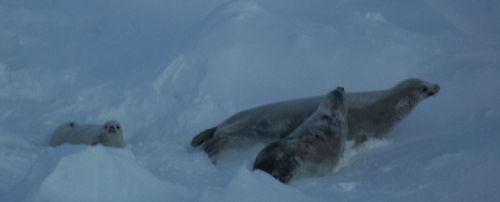Location: In transit from Ice Station Belgica to Peter I Island. Latitude: 69° 08′ S Longitude: **91° 18′ W **Air temperature: -10.8 °C (12.6 °F) Wind chill: - 29.7 °C (-21.5 °F) Wind speed: 18 to 22 knots Barometric pressure: 981.5 mBar
**Antarctic trivia **(answer at the end of this journal entry): Leopard seals, named for the spots on their bellies, are a dominant predator in the Antarctic. Do they have any natural enemies? Wednesday morning we said farewell and adieu to Ice Station Belgica, our home for the past 28 days. Mixed emotions are the rule; we are happy to be headed home again, but sad that our great adventure is coming to an end. We encountered heavy ice throughout the day – the Palmer is rated to break 3 feet of ice at 3 knots, but the going was slow through the heavy ice ridges in the pack ice. Early Thursday morning the ridging became less pronounced and the ice thinner. By late Thursday we were in large pancakes and moving along at a steady 6 knots. Captain Mike and his crew do an amazing job navigating the Palmer through the thick ice. I understand there is quite a bit of strategy involved in getting even a large ship like the Palmer through the ice; I even heard Captain Scott talking about giving the ship a little "English” in certain directions to help navigate tricky ice floes. Interestingly enough, thick snow seems to be as much a problem as thick ice. As we move through the pack ice snow accumulates on the bow of the ship creating friction between the ship and the ice, ultimately reducing the ice-breaking power of the Palmer. Lots of "backing and ramming” occurs in areas where thick snow lies on top of the ice.
We saw many seals on the way Wednesday - too many crabeaters to count, plus a few leopard seals. The crabeaters were mostly in triads – mother and pup with a male. In one 45 minute period on the bridge I spotted 3 of these groups and 2 leopard seals.
 A crabeater seal triad seen on the ice Wednesday.
A crabeater seal triad seen on the ice Wednesday.
An algal bloom (an abundant growth of algae when conditions are favorable) is certainly in evidence now. As the Palmer moves through the floes, blocks of ice are upturned in her wake. These blocks of ice are almost always "stained” a brownish color due to the presence of ice algae. The algae in the water and ice form the basis of the Antarctic food chain. Krill have the role of primary consumer in this ecosystem, with several organisms at the secondary consumer level, including penguins, seabirds, and seals. With abundant algae there will undoubtedly be abundant krill. These krill support the large number of seals we are seeing.
 An abundance of algae stains the ice brown.
An abundance of algae stains the ice brown.
We’re headed for Peter I Island this evening where we’ll stop and wait for daylight tomorrow. The plan is to circle the island in daylight to census the animal life present. Brent thinks we’ll see several species of whales and some seabirds we haven’t seen yet. It is also thought there is a small penguin rookery there.
 Our marine mammal and seabird expert, Brent.
Our marine mammal and seabird expert, Brent.
Thursday morning we set our clocks ahead one hour to observe daylight saving time. The ship’s clocks are set to the same time as our departure and arrival port, Punta Arenas, Chile. It certainly felt weird "falling forward” instead of "falling back” as we do in the northern hemisphere!
As an update to my last journal entry it was suggested that I list other kitchen items (besides instant coffee used for strengthening the communal coffee) we are out of…bacon (this went a while ago, Bill’s bacon was really good), white bread, tomatoes and cucumbers (but we still have lettuce and other fresh things despite being out of port so long), Cheerios (I understand Stian wasn’t happy the morning this was discovered), plastic spoons (nothing like eating yogurt with a fork!), ramen, and our supply of salad dressing seems to be dwindling. On the positive side, there seems to be an abundance of cheesecake and other decadent deserts, roasted peanuts and pecans, Pringles, and other really "bad” good things!
**Answer to today’s Antarctic trivia question: **Leopard seals, named for the spots on their bellies, are a dominant predator in the Antarctic. Do they have any natural enemies?
Unlike other seal species leopard seals have not been exploited by humans, but killer whales find them tasty! But Shamu looks so cute at Sea World…
Marine mammals and seabirds spotted by Brent: Crabeater seal Leopard seal Emperor penguin Adelie penguin Snow petrel Giant petrel

